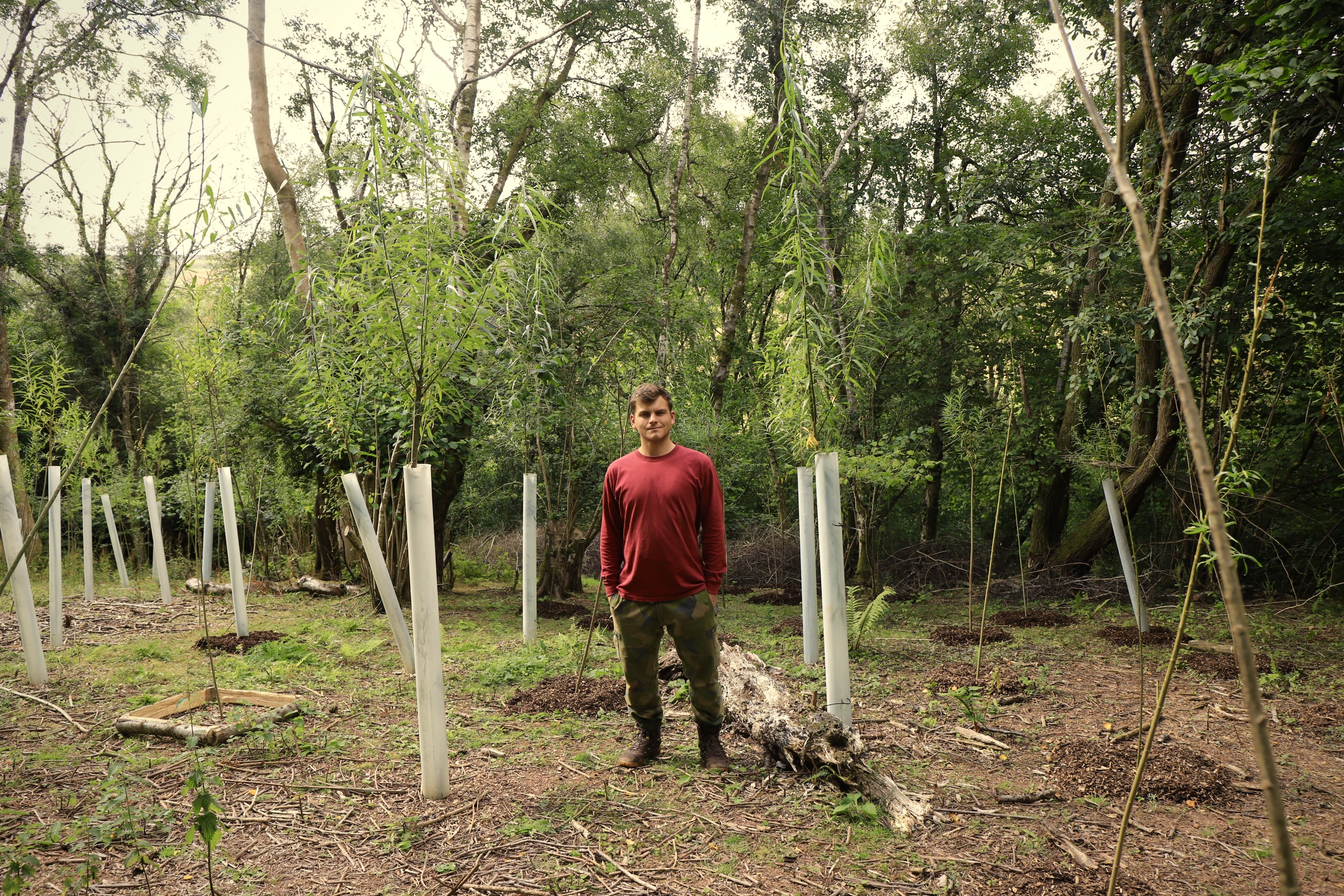Growing an Agroforestry Co-operative
“I feel a responsibility to the landscape and future generations” - Chris Wilmoth on a willow plantation aimed at demonstrating how high-density short-rotation pollarding could provide a sustainable agroforestry income stream.

Former aerospace engineer Chris Wilmoth returned to the smallholding where he grew up near Minehead in Somerset following the Covid pandemic.
He started to consider how he might be able to develop the smallholding’s unmanaged woodland. He wanted to enhance the landscape and the biodiversity while helping local farmers add an income stream from agroforestry and coppice.
In an area rich in traditional sheep farming, he hopes to demonstrate how pollarded willow plantings could produce a crop within two years. Pollarded willows will have little impact on light reaching the grass. They could even increase the grazing season for sheep by reducing water levels in the soil in the winter and thus reducing the poaching of the ground (breakdown of soil under weight of animals).
Chris is actively working to set up a co-operative in West Somerset and North and Mid Devon to engage other young forestry, farming and woodland enthusiasts in the project through links with the Devon Coppice and Small Woods Group and other local organisations.
The aim of the co-operative is to enable landworkers to gain free access to land and to obtain affordable accommodation next to it. He hopes to see the co-operative enter into collaboration agreements with local farmers to plant and manage agroforestry and coppice schemes and to market products, delivering maximum value to landworkers. Farmers will be benefit using Sustainable Farming Incentive payments that they would not ordinarily undertake themselves. This would make it a win-win-win for landworkers, nature and farmers.

The Site
The 20-hectare (ha) family smallholding is approximately half grazing land, let out to local farmers, and half overgrown woodland. It lies on the very edge of Exmoor, bounded by a tributary to the River Avill and the National Trust’s Holnicote Estate and is within the National Park.
Much of the existing woodland is hazel and ash, with Ash Dieback beginning to take a hold locally. Other existing species include common alder, holly, hawthorn, and birch with some beech, blackthorn, rowan, and oak.
The smallholding was originally bought by Chris’s great uncle. Although some of the woodland may have been deliberately planted and once coppiced, it is more likely that it has developed naturally over time.
Historically the family has left the woodland to itself. For Chris, whose day job is now with the Environment Agency working on flooding mitigation, it offers an opportunity to work within the woodland and landscape he loves.
Chris successfully applied for a Royal Foresty Society Grant for Resilient Woodlands for 230 trees on a small 0.16 ha area on the smallholding named Keltings Copse in memory of his great uncle. The Copse sits at 190-210m elevation on a North facing slope and mostly on acidic clay soils. Chris cleared it of brambles and bracken and left a few hazel trees which he has pollarded and ash trees as standards within the area.

Species Choice
Four willow species were chosen: Bowles Hybrid, Black French, Zwarte Drie Bast and Norfolks to add diversity to try and mitigate against pests and diseases. Two species, Bowles Hybrid and Black French, are renown for vigorous growth of up to 2metres a year.
Planting and Maintenance
The trees were bought at approximately 2m high from specialist willow grower Jenny Crisp and planted in February 2024 at 1.5m spacings in a random mix. A donation of pre-loved (used) tree guards has meant Chris has been able to add protection from red deer for some of the trees.
Chris trimmed some of the willows before planting them and planted those offcuts as live cuttings along the edge of the site, partly as sacrificial trees. Many of these have taken and may also reach pollarding height in a few years.
Some trees were mulched with bracken brash, some with woodchip and others with a mix of cardboard and woodchip. A second mulch of woodchip was added in July 2024. Chris found that mulching with cardboard attracted animals who in turn destroyed the mulch rendering it ineffective.
Pine martens may be released in Exmoor soon and Chris will install boxes to encourage them to help control grey squirrel populations.
By summer 2024 there was an almost 100% uptake of the trees, helped by a wet spring. There is some minor damage to some bark, possibly from squirrels or voles. However, few trees have died as a result.
Chris will pollard half of the trees – Bowles hybrid and Black French – in spring 2025. In 2026 the remaining half will be pollarded. Thereafter each tree will be cropped every other year, creating, hopefully, a crop and an income every year, whilst retaining a canopy.
A hard-standing track suitable for a 4×4 runs by the Copse providing ease of extraction from the bottom of the Willow agroforestry system.
“Farming is very traditional and farmers want to see a quick return if they are going to make changes to the way they do things. By demonstrating a scheme which is scalable, I hope to be able to help this area reach England’s woodland cover targets."
Potential Markets
Chris has researched high-end markets for willow products such as salicylic acid production for hand creams and rooting agents.
But it is compressed artist-grade charcoal which is likely to find both a quick and a high return for investment. Willow grown on the Somerset Levels is largely sold to that market across the world.
Next Steps
Chris hopes to launch the co-operative in early 2025.
The pollarded willow represents an experiment, applying some of Chris’s plans for the co-operative. He is also exploring options to introduce 14 species on a 7, 14 and 21-year rotation coppice in other areas of the woodland on the smallholding. He would then scale these coppice management and marketing practices through the co-operatives’ offering.
He has already sought advice from a wide range of experts and organisations including the late Alan Waters of WildWood Coppice in West Sussex and from Brian Williamson who manages a coppice at Westonbirt (The National Arboretum).
As well as being a member of the Royal Forestry Society, Chris is a member of the Devon Coppice and Small Woods Group (part of the National Coppicing Federation (NCFed) and the Land Workers Alliance (LWA) and its Forestry Sector sub-group

More Information
If you are interested in learning more about this project, please email us at rfshq@rfs.org.uk
Grants for Resilient Woodlands
Our Grants for Resilient Woodlands are funded by Train Hugger and Green The UK. They are open for applications from Royal Forestry Society (RFS) and Royal Scottish Forestry Society (RSFS) members all year round.
These grants are to help people plant trees that will survive and thrive into the future. Creating better, more resilient treescapes for our environment, for people and for the economy.



